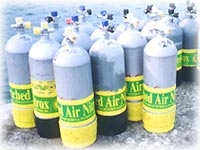
Nitrox, or Enriched Air (EAN), is air with a higher concentration of Oxygen. Air is 79% Nitrogen and 21% Oxygen. Nitrox is usually between 30% and 40% Oxygen.
Good things: - Theoretically decreases your risk of DCS since the Nitrogen percentage is lowered in the air you breath (and DCS is caused by excess Nitrogen bubbles in your body).
- Gives you more bottom time. IE: Using Nitrox with 36% Oxygen, the max bottom time for a dive to 80 feet is 55 minutes vs. 30 feet using regular air.
- Possibly helps with headaches and "the munchies" after diving, but this hasn`t been scientifically tested.
Bad things: - Nitrox tank fill costs more than regular air fill (usually around $10 vs. $5 for air).
- Equipment needs to be serviced and "made ready" for Nitrox. IE: special lubricant needs to be used to accomodate higher Oxygen percentages.
- Might die from Oxygen Toxicity at lower depths. If you are exposed to a high partial pressure of Oxygen (1.4 ata and greater) you could suffer from Oxygen Toxicity. Nitrox with 36% Oxygen (EANx36) gets you to 1.4 partial pressure of Oxygen around 128 feet (39 meters). With regular air, you would have to dive to around 220 feet (66 meters) to get the same level of Oxygen exposure.
Overall, if you don`t mind the extra cost...and you are diving between 70 and 110 feet, Nitrox is a great choice since it will greatly extend your bottom time. Otherwise, if you are usually diving less than 70 feet, save the money and stick with regular air.
by Greg Davis - Founder of DiveBuddy.com
